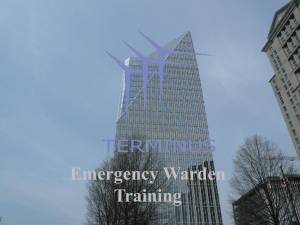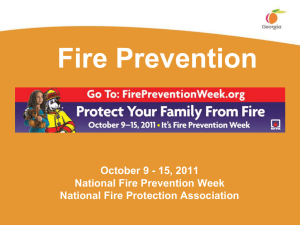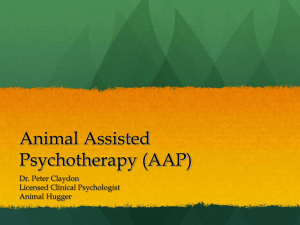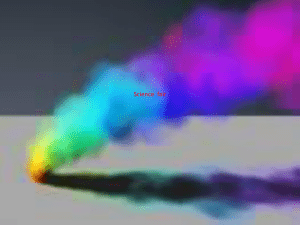Assisted Living/Personal Care-Allen LaBerteaux
advertisement
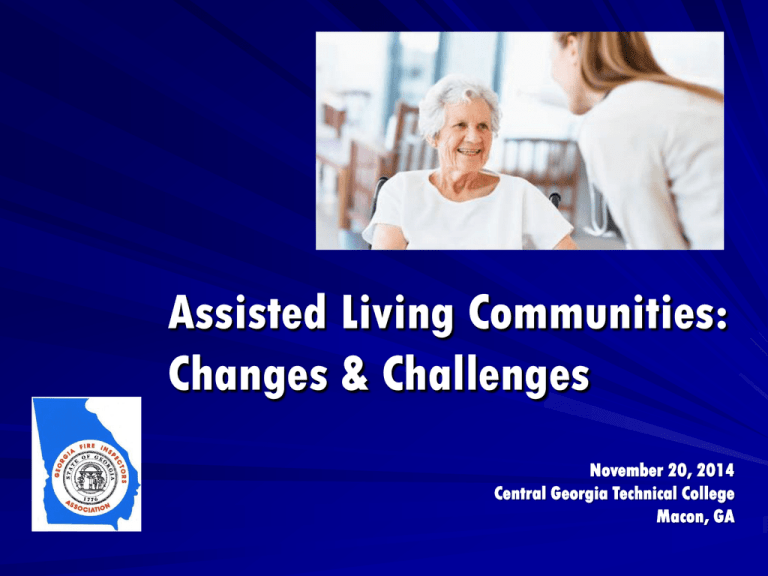
Assisted Living Communities: Changes & Challenges November 20, 2014 Central Georgia Technical College Macon, GA Law of Unintended Consequences SB 178 was created and passed into Law in January of 2012 to amend Chapter 7 of Title 31 of the Official Code of Georgia Annotated. Legislation required the State Fire Marshal’s Office to review and inspect the newly created Assisted Living Communities under Limited Healthcare designation due to the nature of the residents cared for. 2 Law of Unintended Consequences Being mandated to review and inspect Assisted Living Communities as Limited Healthcare presented a number of challenges to both the Industry as well as the State Fire Marshal’s Office. It soon became apparent that many providers would not be able to change licensure to an Assisted Living. This lead to the creation of Chapters 34 and 35 in the current OCGA 120-3-3, adopted January 30, 2014. Previously these chapters were reserved in the LSC. 3 Law of Unintended Consequences The Georgia State Fire Marshal’s Office soon began a series of meetings, code analysis and research of how other states have approached this unique problem. After several months and numerous meetings, a solution began to emerge that was acceptable to the Industry as a whole while maintaining the safety of the residents being served by the Industry. 4 Jurisdiction Although Assisted Living Communities are reviewed under Chapters 34 and 35 of the 2012 NFPA 101 Life Safety Code, as modified by OCGA 120-3-3, SB 178 designates Assisted Living Communities as Limited Healthcare, and therefore remains a State Jurisdiction. All inspections and plan reviews must come through the State Fire Marshal’s Office. 5 Jurisdiction This does not mean a local jurisdiction cannot enter upon the premises. Just as with Healthcare facilities, if any issues or concerns are found, forward those to the State Fire Marshal’s Office. 6 New and Existing Facilities New Facilities are held to more stringent requirements, primarily construction type limitations and sprinkler requirements. Existing Facilities (existing Personal Care Homes conversions) are less stringent in requirements but concessions were made. Construction type/number of stories limitations Sprinkler requirements NFPA13R with modifications vs an NFPA 13 system Not all existing facilities will qualify. 7 Does a Facility Qualify for Conversion? Not all facilities will qualify to convert to an Assisted Living Community. The three biggest challenges are: * Construction Type/Number of Stories * Sprinkler System NFPA13R with modifications * Financial Constraints 8 35.1.6 Minimum Construction Requirements. Assisted living community facilities shall be limited to the building construction types specified in Table 35.1.6 (see 8.2.1), based on the number of stories in height as defined in 4.6.3. Table 35.1.6 Number of Stories - See Note b Construction Type Sprinklered See Note a 1 2 3 4 5-6 >6-12 Type I (442) c d Yes No X N.P. X N.P. X N.P. X N.P. X N.P. X N.P. Type I (332) c d Yes No X N.P. X N.P. X N.P. X N.P. X N.P. X N.P. Type II(222) c d Yes No X N.P. X N.P. X N.P. X N.P. X N.P. X N.P. Type II(111) c d Yes No X N.P. X N.P. Xe N.P. Xe N.P. N.P. N.P. N.P. N.P. Type II(000) a Yes No X N.P. X N.P. N.P. N.P. N.P. N.P. N.P. N.P. N.P. N.P. Type III(211) a Yes No X N.P. X N.P. Xe N.P. Xe N.P. N.P. N.P. N.P. N.P. Type III(200) a Yes No X N.P. N.P. N.P. N.P. N.P. N.P. N.P. N.P. N.P. N.P. N.P. Type IV(2HH) a Yes No X N.P. X N.P. N.P. N.P. N.P. N.P. N.P. N.P. N.P. N.P. Type V(111) See note a or e Yes No Xa N.P. Xa N.P. Xe N.P. Xe N.P. N.P. N.P. N.P. N.P. Type V(000) a Yes No Xa N.P. N.P. N.P. N.P. N.P. N.P. N.P. N.P. N.P. N.P. N.P. X = Permitted if sprinklered as required by 33.3.3.5 unless otherwise noted. NP = Not permitted. a Building shall be protected throughout by an approved supervised automatic sprinkler system installed in accordance with 35.3.5, and the interior walls are covered with lath and plaster or materials providing a 15-minute thermal barrier. (See requirements of 35.3.5). b See requirements of 4.6.3. c See requirements of 35.1.6.2.1. d See requirements of 35.1.6.2.2. e See requirements of 35.1.6.5. 9 Definitions Previously, Personal Care, Assisted Living and Residential Board and Care were reviewed under Chapters 32 and 33 of the 2000 edition of the Life Safety Code. SB178 creates and clearly defines Assisted Living Communities. Assisted Living Communities are defined as 25 or more beds with residents who are capable of assisted self-preservation, with the intention to allow the resident to age in place. 10 Definitions 120-3-3-.03(4) Assisted Living Community (ALC) means facility serving 25 residents or more that is licensed by the Georgia Department of Community Health and meets the requirements of an existing health care occupancy found in Chapter 19 of the Life Safety Code or the requirements established in Chapter 34 or 35 of the Life Safety Code as may be applicable for new or existing facilities. 11 Definitions 120-3-3-.03(5) Assisted self-preservation as applied to an Assisted Living Community (ALC) means the capacity of a resident to be evacuated from an assisted living community to a designated point of safety and within an established period of time as determined by the Office of the Safety Fire Commissioner. Assisted self-preservation is a function of all of the following: (A) the condition of the individual; (B) the assistance that is available to be provided to the individual by the staff of the assisted living community, and (C) the construction of the building in which the assisted living community is housed, including whether such building meets the safety requirements applicable to an existing Health Care Occupancy or an Assisted Living Community as established by Chapter 34 or 35of NFPA 101, Life Safety Code, as may be applicable respectively to a new or existing facility, and other safety to life provisions as adopted by the Rules and regulations of the Safety Fire Commissioner.” (Also see the definition for “Self-Preservation”) 12 Definitions 120-3-3-. (24) Self-Preservation, except as defined in NFPA 101, Life Safety Code for day-care occupancies, means the ability to respond to an emergency condition, whether caused by fire or otherwise, and escape the emergency without physical, hands-on assistance from staff. The resident may move from place to place by walking, either unaided or aided by prosthesis, brace, cane, crutches, walker or handrails, or by propelling a wheelchair. 13 Why Healthcare? Assisted Self-Preservation – this is what drives the Healthcare Designation. Self-preservation is the act of an individual being able to independently evacuate a building or to a point of safety without assistance from others. With assisted self-preservation, evacuation time is even more critical. 14 Evacuation and Fire Drills Prompt Evacuation – Achieved in 3 minutes or less, night or day. Slow Evacuation – Achieved in more than 3 but in not less than 13 minutes, night or day. Impractical Evacuation – Achieved in more than 13 minutes, night or day. (Above definition as modified by OCGA 120-3-3). 15 Evacuation and Fire Drills The Code does require for any facility or individual that cannot be effectively evacuated in 13 minutes or less to provide additional, dedicated staff for those residents. 16 Evacuation and Fire Drills Emergency Egress and Relocation Drills shall be conducted no less than once per quarter per shift at alternating times. One total building evacuation a year is required, other drills may include evacuation to a Point of Safety. Drills may be announced before hand Record keeping of all drills is required. 17 Evacuation and Fire Drills Point of Safety refers to a location such as exterior door, rated stairwell, or opposite side of a one-hour rated smoke barrier wall. Considered a Healthcare Occupancy, ALCs are a Defend In Place facility. 18 Egress 35.2.3.3 The width of corridors serving an occupant load of 50 or more in facilities having prompt or slow evacuation capability, and all facilities having impractical evacuation capability, shall be sufficient for the occupant load served but shall be not less than 60 in. (1525 mm). 35.2.3.4 The width of corridors serving an occupant load of less than 50 in facilities having prompt or slow evacuation capability shall be not less than 44 in. (1120 mm). 19 Egress 35.2.5.2 Dead-end Corridors. Dead-end corridors shall not exceed 35 ft. (15 m). (30 ft. for new construction) 35.2.5.3 Common Path. Common paths of travel shall not exceed 110 ft. (35.5 m). (75 ft. for new construction) 20 Travel Distance to Exits 35.2.6 Travel Distance to Exits. 35.2.6.1 Travel distance from any point within a room, suite, or living unit to a corridor door shall not exceed 75 ft. (23 m) in buildings not protected throughout by an approved automatic sprinkler system in accordance with 35.3.5. 35.2.6.2 Travel distance from any point within a room, suite, or living unit to a corridor door shall not exceed 125 ft. (38 m) in buildings protected throughout by an approved automatic sprinkler system in accordance with 35.3.5. 21 Travel Distance to Exits 35.2.6.3 Travel distance from the corridor door of any room to the nearest exit shall be in accordance with 35.2.6.3.1or 35.2.6.3.2 35.2.6.3.1 Travel distance from the corridor door of any room to the nearest exit, measured in accordance with Section 7.6, shall not exceed 200 ft. (61 m). (150 ft. for new construction) 35.2.6.3.2 Travel distance to exits shall not exceed 200 ft. (61 m) for exterior ways of exit access arranged in accordance with 7.5.3. (150 ft. for new construction) 22 Corridor/Sleeping Room Separation 35.3.6.1.1 Sleeping rooms shall be separated from corridors, living areas, kitchens and all other areas by walls having a minimum 1/2-hour fire resistance rating. 35.3.6.1.3 Rooms or spaces, other than sleeping rooms and hazardous areas, shall be separated from corridors by smoke partitions in accordance with Section 8.4, and the provisions of 8.4.3.5 shall not apply. 23 Corridor/Sleeping Room Separation 35.3.6.4.1 Doors shall have a minimum 20-minute fire protection rating. 35.3.6.4.2 Solid-bonded wood-core doors of not less than 1 3/4 in. (44 mm) thickness shall be permitted to continue in use. (No fire rating required, but must resist passage of smoke in new construction) 35.3.6.5.1 Door-closing devices shall not be required on doors in corridor wall openings, other than those serving exit enclosures, smoke barriers, enclosures of vertical openings, and hazardous areas. 24 Subdivision of Building Spaces Every sleeping room floor shall be divided into 2 smoke compartments of approximately the same size. Each smoke compartment shall not exceed 22,500 ft2 Smoke barriers shall not be required in facilities with prompt or slow evacuation capabilities where each sleeping room has access to an exterior exit. 25 Subdivision of Building Spaces Every sleeping room floor shall be divided into 2 smoke compartments of approximately the same size. Each smoke compartment shall not exceed 22,500 ft2 Smoke barriers shall not be required in facilities with prompt or slow evacuation capabilities where each sleeping room has access to an exterior exit. 26 Subdivision of Building Spaces 35.3.7.3 The travel distance from any point to reach a door in the required smoke barrier shall be limited to a distance of 200 ft. (61 m). 27 Subdivision of Building Spaces Existing facilities of construction Type II(111), Type III(211)or Type V(111) shall prohibit residents who require assistance for preservation to first and second stories unless facility is equipped with combination of smoke barrier and horizontal exit on the third and fourth floors; or, protected throughout by an approved automatic, supervised NFPA 13 sprinkler system with quick response or residential heads. 28 Sprinkler Coverage New Facilities require full NFPA 13 Sprinkler System. Existing Facilities (conversions) require NFPA 13R system as modified (Sprinkler coverage in all restrooms and closets regardless of their size). Non-sprinkled attics (NFPA 13R systems for existing facilities) shall be provided with heat detection, connected to fire alarm control panel and emergency forces notification. 29 Smoke Detection Each resident sleeping room shall be provided with smoke detection, hardwired to the building’s electrical system. Where approved by the AHJ, existing battery operated smoke alarms may be allowed to remain with acceptable record keeping, testing, maintenance and battery replacement. Existing battery powered smoke alarms, when replaced or installed on or after Jan. 1, 2014, shall be non-replaceable, nonremovable, tamper resistant and shall be powered for a minimum of 10 years. 30 How to Get Started To determine a facilities’ qualification, contact the Georgia State Fire Marshal’s Office. ALL requests must be in writing. Go to http://oci.ga.gov/ExternalResources/Forms/AllForms/GID342-SF.pdf Or Fax request to 678-717-5877. Allow 21 working days to schedule inspection. We also strongly recommend retaining the services of a registered architect or engineer prior to requesting inspection. 31 Contact Information Mailing Address: – State Fire Marshal’s Office 2 Martin Luther King Jr. Drive Suite 920, West Tower Atlanta, Georgia 30334 www.gainsurance.org Engineering/Inspections – Telephone (404) 656-7087 – FAX (678) 717-5877 – E-mail inspections@sfm.ga.gov Allen LaBerteaux – Telephone (404) 617-6653 – alaberteaux@sfm.ga.gov 32
